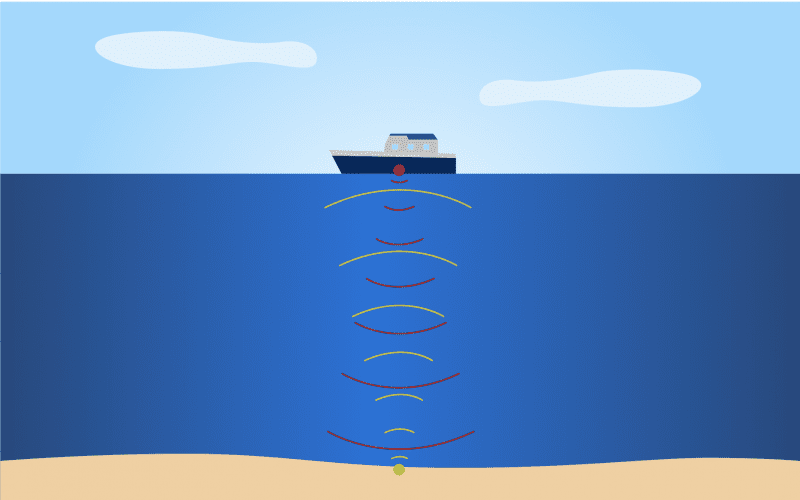Ever wondered how bats fly so easily in the dark? ‘Bio Sonar’ or ‘Echolocation’ is produced by certain animals to navigate their way in the dark. A flying bat generates ultrasound to find the distance and density of the obstructing object and pilots itself accordingly. SONAR (Sound Navigation and Ranging) is based on the same unique technique of sound propagation to detect or locate objects that are out of our reach or obscured. It was first used by Leonardo da Vinci when he submerged a tube underwater and listened through the opening on above to determine the location of other vessels. However, the first sonar-like equipment was created by a Naval Architect Lewis Nixon and now is widely used to detect an object or vessel underwater by using ultrasound waves. This blog explores the major applications of Sonar, it’s major types and how it actually works.
Fun Facts:
Bats are the only amazing nocturnal mammals that can fly!
Despite having an unclear vision, most of the ‘Batman’ business is done at night!
There are over 1000 Species of bats that are almost a quarter of mammals!
How does SONAR work?

Before exploring the applications of Sonar, let’s first understand how it works. To begin with, a transmitter and detector/receiver are installed in the vehicle. The transmitter produces echos or ultrasonic waves that travel across the water. Once the waves hit an object or any obstacle, the detector immediately receives a signal. These ultrasonic sounds are then converted into electronic signals which are interpreted accordingly. The time interval taken place between transmission and reception is noted and that’s how the Sonar technology is operated.
Types of SONAR
Sonar is simply based on the phenomenon of echoes to determine the fairness of an object or depth of the water body by the bouncing back of echoes. Before elaborating upon the applications of Sonar, let’s first take a look at its types:
- Active Sonar: A pulse of sound is sent inside the water which hits the object and is reflected back. The distance is measured by the time taken by the waves (echoes) to return back.
- Passive Sonar: As the name suggests, Passive Sonar doesn’t send attention or soundwaves. The applications of this type of Sonar is mainly used in receiving sounds or noise of the water body or to locating other ships, submarines and icebergs.
Did You Know: If The Titanic would have been equipped with the Sonar technology, the tragic disaster could be avoided!
Applications of Sonar
Sonar plays an imperative role for different purposes in Marines such as finding the depth of the sea, finding lost ships and is also used for security purposes in the military. Let’s travel deeper into explore the major applications of SONAR.
Naval Forces/Military
Sonar is extensively used by naval warfares in both active and passive forms. The use of sonar in submarines helps them hide at the detection of an ‘echo’ or sound wave. This helps them locate enemies. Amongst the most popular applications of Sonar, it also helps in underwater security by detecting Frogmen (a combat scuba diver who is from the Police or Military service). Further, it is also used for underwater communication as passive sonars are ‘silent’ listeners which make it stand ahead in advantages. It has a greater range and can identify the noise of the target since every engine makes a different sound. Sonar can also powerfully determine the location of an aeroplane crash in the sea.
Submarines
Another important one in the different applications of Sonar is how extensively it is used by submarines. Once the submarine commander detects a clear signal, they can move faster without worrying about the noise of the submarine making it a safe move. Since active sonars can be able to detect the Person/ship sending the signal, it is also used in noisy situations or platforms or by transportation that is fast.
For Fishing
Fishing also comes under a prominent area of applications of Sonar as modern commercial fishermen use it to detect fishes. Sound waves travel differently and some pass through the fish bladder because of varying density. Such reflections allow the fishermen to determine different schools of fish in the water and catch them accordingly.
Along with these, active sonars are used to detect the depth of water by ships. Sonar is also used to detect a gas leak on the seabed. The quantity of the gas leak cannot be determined accurately but will allow an estimation.
Thus, the use of Sonar is important for various scientific, military, and medical purposes. Despite being such an effective mechanism, Sonar can be detrimental to marine life. It is essential for us to stay conscious of the environment around us and make sure we co-exist with other species without harming them. We hope that you found this blog on applications of Sonar informative and insightful! Are you interested in studying Naval Engineering? Reach out to our Leverage Edu experts and we will guide you in selecting the best course and university as per your interests and aspirations! Sign up for a free session with us today!

 One app for all your study abroad needs
One app for all your study abroad needs




















 25,000+ students realised their study abroad dream with us. Take the first step today.
25,000+ students realised their study abroad dream with us. Take the first step today.

